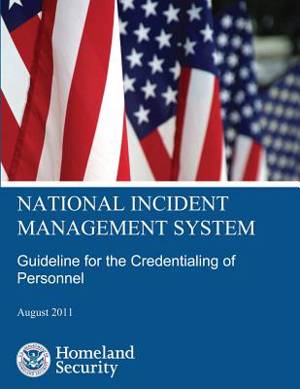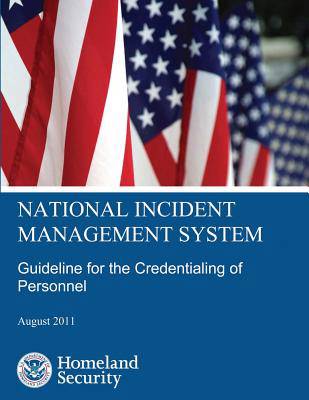
- Retrait gratuit dans votre magasin Club
- 7.000.000 titres dans notre catalogue
- Payer en toute sécurité
- Toujours un magasin près de chez vous
- Retrait gratuit dans votre magasin Club
- 7.000.0000 titres dans notre catalogue
- Payer en toute sécurité
- Toujours un magasin près de chez vous
National Incident Management System Guideline for the Credentialing of Personnel
U S Department of Homeland Security
Livre broché | Anglais
27,95 €
+ 55 points
Description
The Department of Homeland Security (DHS)/Federal Emergency Management Agency (FEMA) developed the National Incident Management System (NIMS) Guideline for the Credentialing of Personnel (the guideline) to describe national credentialing standards and to provide written guidance regarding the use of those standards. This document describes credentialing and typing processes and identifies tools which Federal Emergency Response Officials (FERO) and emergency managers at all levels of government may use both routinely and to facilitate multijurisdictional coordinated responses. Through this guideline, DHS/FEMA encourages interoperability among Federal, State, local, territorial, tribal, and private sector officials in order to facilitate emergency responder deployment for response, recovery, and restoration. This guideline also provides information about where emergency response leaders can obtain expertise and technical assistance in using the national standards or in ways they can adapt the standards to department, agency, jurisdiction, or organization needs. Each Federal agency with responsibilities under the National Response Framework is required to ensure that incident management personnel, emergency response providers, and other personnel (including temporary personnel) and resources likely needed to respond to a natural disaster, act of terrorism, or other manmade disaster are credentialed and typed in accordance with 6 U.S.C. Section 320. In addition, Homeland Security Presidential Directive - 5 (HSPD -5), Management of Domestic Incidents, requires that the heads of Federal departments and agencies adopt the National Incident Management System. DHS interprets these authorities to require agencies to ensure that their personnel are credentialed and typed according to these guidelines. Federal Legislative and Judicial Branches, State, local, tribal, private sector partners, and non-governmental organizations (NGO) are not required to credential their personnel in accordance with these guidelines. These non-Federal entities do not need to comply with the Federal Information Processing Standards (FIPS) 201, an open technical standard used by Federal officials for uniform credentialing and access control or other Federal identification requirements for emergency response purposes. However, DHS/FEMA strongly encourages them to do so, in order to leverage the Federal investment in the FIPS 201 infrastructure and facilitating interoperability for personnel deployed outside their home jurisdiction.This document, developed and maintained by DHS/FEMA, is written for government executives; emergency management practitioners; private-sector, volunteer, and NGO leaders; and critical infrastructure (CI) owners and operators. It is addressed to senior elected and appointed leaders, such as Federal department and/or agency heads, State governors, mayors, tribal leaders, and city and/or county officials who have a responsibility to provide effective response. It also is intended for use by private-sector entities entering an impacted area to carry out their own response and recovery activities within the Incident Command System (ICS). For these users, this guideline is augmented with online access to supporting documents, further training, and an evolving resource for exchanging lessons learned.This guideline applies to incidents such as large-scale terrorist attacks or catastrophic natural disasters where mutual aid and multijurisdictional aid is required. It can be useful for international cross-border initiatives undertaken by States and tribes.
Spécifications
Parties prenantes
- Auteur(s) :
- Editeur:
Contenu
- Nombre de pages :
- 38
- Langue:
- Anglais
Caractéristiques
- EAN:
- 9781484111529
- Date de parution :
- 13-04-13
- Format:
- Livre broché
- Format numérique:
- Trade paperback (VS)
- Dimensions :
- 216 mm x 280 mm
- Poids :
- 113 g

Les avis
Nous publions uniquement les avis qui respectent les conditions requises. Consultez nos conditions pour les avis.






